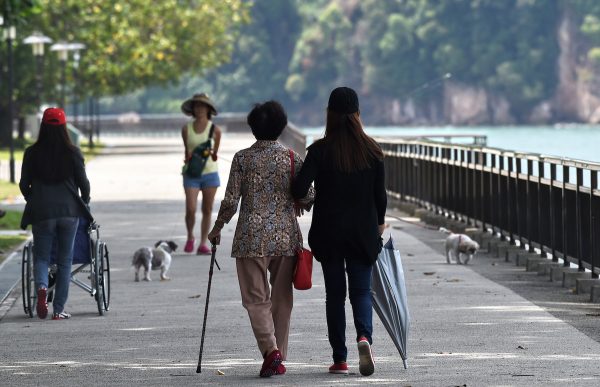
How is caregiving holding women back?


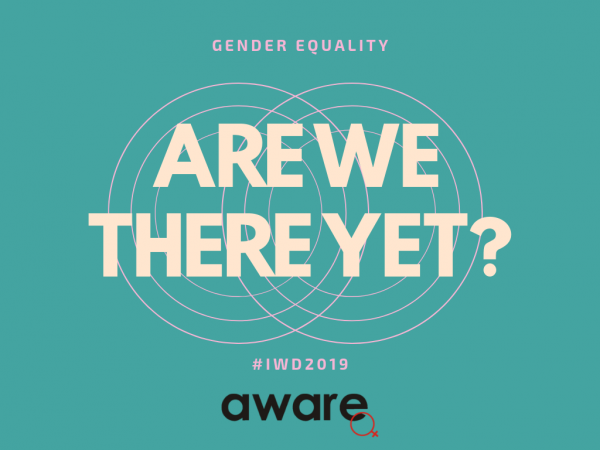
By Shailey Hingorani, Head of Advocacy and Research, AWARE
Congratulations: We’ve made it to International Women’s Day 2019. Let’s take a breath, pat ourselves on the back, put our feet up… and bask for a while in joyful appreciation of how far women have come.
After all, in many ways, life is better today than it has ever been for women — particularly in affluent, peaceful Singapore. For many around the world, the country’s name evokes visions of safety and security, of moderation and egalitarianism. No surprise that many Singaporeans believe that the struggle for gender equality is over.
Done looking back at our achievements? Great! Now let’s look ahead at the work we have to do. Because the truth is — as our work at AWARE shows over and over — the lived experiences of women in the nation paint quite a different picture than the rosy one above. As a society, we have a lot more ground to cover before every person is afforded the same rights and opportunities, regardless of gender.
So what are five major potholes that remain in Singapore’s road to gender equality?
1. Mind the gender pay gap
“But gender equality already exists” proponents often point to the fact that women in Singapore have equal access to education and work. Yes, women in Singapore make up almost half of the workforce, but they are also being paid a startling 20 per cent less than men. So labour force participation is not the full story. The gap doesn’t diminish as women climb the career ladder. Surprisingly, only 10 per cent of all corporate directors of SGX-listed firms are women, and they are paid an enormous 43 per cent less than their male counterparts.
2. Caregiving doesn’t count
The traditional family portrait depicts women as the “caregivers” and men as the “primary breadwinners”. Families and labour markets alike continue to function largely based on this assumption. The stereotype does not just affect the different roles each gender plays at home. It also affects women’s ability to participate in the labour force, and the quality, duration and type of jobs they can take up. A study by the International Labour Organization (2018) shows that women in Asia and the Pacific spend 4.1 times more time in unpaid care work than men. In Singapore, 43 per cent of women who are not working listed family responsibilities as the reason they are unable to work. In comparison, only 3.8 per cent of men cited family responsibilities as their main reason for not working.
To make matters worse, women are penalised under Singapore’s CareShield health insurance scheme, which has gender-differentiated premiums. So not only do women bear a disproportionate part of the caregiving burden throughout their lives — when they require care themselves, they often have to pay more for it. This practice is unlawful in the EU, where insurance premiums and benefits cannot be differentiated on the basis of gender.
3. Women do more low-wage work
Occupational segregation is a persistent feature of the labour market in Singapore. Some sectors have become integrated over time but others, like the long-term care sector, are dominated by women. Over 90 per cent of paid care work is done by women, who on average earn a mere $1,350 per month — well below the monthly income of the bottom 10 per cent ($1,927).
One could argue, as many do, that women intentionally choose low-paying jobs. But if this was indeed a problem of individual choice then we wouldn’t see empirical evidence of occupation-wide wages falling when a large number of women join a hitherto largely male-dominated occupation. A robust study on the gender pay gap — controlled for everything from education to work experience to race — found that in the U.S., after women became designers, occupation-wide wages fell by 34 per cent. So a bigger problem here might be that we see women’s labour as being inherently less worthy than men’s.
Many economists believe occupational segregation to be economically inefficient. It doesn’t allow for movement into occupations where women could perform well, and is also one of the main reasons why the gender pay gap persists.
4. Retirement spreads thinner
The impact of gender inequality does not end once a woman stops working in Singapore. It continues into her retirement savings, too. Since women earn less than men and spend more time outside the labour force (thanks to caregiving), they have less money going into their CPF retirement savings and Medisave accounts. Currently, the CPF savings gender gap between male and female active members is 11 per cent. Given that women outlive men by 7 years, they typically need more, not less, savings.
5. Workplaces remain unfriendly
In 2017, 21 per cent of the 515 cases that AWARE’s Sexual Assault Care Centre (SACC) saw involved sexual violence and harassment at the workplace. Workplace harassment has a significant impact on women’s overall psychological and physical well-being, of course, but also their career progression. Although the Tripartite Advisory on Managing Workplace Harassment advises employers to develop a strong anti-harassment policy, such policies have not been made mandatory.
More worryingly, despite a growing global awareness of the prevalence of sexual harassment, 34 per cent of respondents in a new Ipsos report on gender perceptions (2019) believe that false accusations of sexual harassment are a bigger problem in our society than unreported acts of sexual harassment. In reality, most cases of sexual assault or harassment remain unreported, and in fact according to global data only 2-10 per cent of all rape accusations are proven to be false. SACC, Singapore’s only specialised centre for sexual assault survivors, found that approximately 7 in 10 clients who reached out for help in 2016 did not make police reports.
We fail women who suffer harassment when we allow the false accusation myth to pervade. We fail them when we indulge in cultural habits such as victim-blaming, and neglect to hold perpetrators accountable.
So no, we’re not there yet
Gender equality has come a long way, but it has not come far enough. The gender gap is still unconscionably wide. It will not close until women’s work is recognised as equal work, caregiving is acknowledged as the labour it is, and sexual perpetrators are held accountable for their actions. Let’s use this post as a checklist of things to keep fighting for.
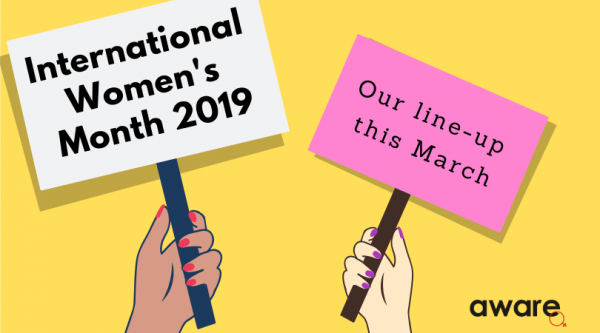





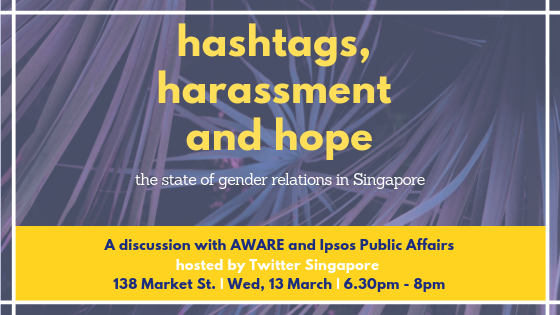
It’s been more than a year since #MeToo became a global phenomenon, rippling out into every sector of society as survivors of sexual harassment spoke up about their experiences. As its impact reached Singapore’s shores, AWARE began receiving a record surge in clients at its Sexual Assault Care Centre – a surge that has yet to subside.
But what other effects has #MeToo had on Singaporean society? Has the movement only improved interactions between genders, or has it in fact had any negative consequences? What gaps in understanding have we yet to bridge? And, now that we’ve told our stories about sexual harassment (and listened to others’ stories), where do we go from here?
After International Women’s Day 2019, join AWARE and market research company Ipsos on 13 March as we tackle those questions.
We’ll present the results of Ipsos’s eye-opening new survey on gender relations in Singapore, which follows on from its ground-breaking exploration of Singaporeans’ attitudes towards Section 377A and susceptibility to fake news. This detailed survey of n=1,000 citizens and permanent residents investigates Singaporeans’ perceptions of: the wage gap; sexual harassment; quotas; and the local impact of #MeToo. The findings of this research add to the growing volume of social discussion regarding gender parity in Singapore today.
A panel discussion will follow, featuring:
This event is for anyone who wants to carry on the fight for gender equality, and use their position to make meaningful change.
Refreshments (halal bites and beverages) will be provided. Proceeds from tickets will go to AWARE. Please note that we will not be accepting refunds.
About Ipsos Public Affairs:
Ipsos Public Affairs is the worldwide leader in social and government research, with a presence in more than 41 countries. Ipsos Public Affairs specialises in enhancing understanding of the perceptions of citizens, focusing primarily on the most defining issues of our time (including, but not limited to, public health, climate change and economic disparities).

“They didn’t say no.”
“But they didn’t say yes, either.”
One experience of sexual assault is one experience too many. We may not always know the right words to say, but we can all agree that sexual assault should never happen to anyone.
One way of showing zero tolerance for sexual assault is by understanding the issue better and getting rid of pre-conceived notions and myths surrounding sexual assault. Failing to question these myths can sometimes lead to victim-blaming, which is detrimental to a survivor’s recovery.
It has been said that awareness is the greatest agent for change. Indeed, understanding an issue is the first step in addressing it. However, sexual assault is an extremely sensitive and personal matter. How can we get to know more about it in a manner that is respectful of the complexities surrounding the issue?
To build a culture of support for survivors of sexual violence, Derring-Do Dance (which runs dance and body-based programmes for kids and families) will partner with AWARE’s Sexual Assault Care Centre for a Sexual Assault Awareness Training session. Taking place at the AWARE Centre, training will run from 10am-12pm, followed by a 30-minute discussion on working with child sexual assault survivors. The workshop will cover:
1. Understanding sexual assault and harassment
2. Understanding your role in supporting survivors
3. Resources available for help
Details are as follows:
When: 23 March 2019, 10am – 12pm, with a discussion on child sexual assault survivors from 12pm to 1230pm [2.5 hours]
Where: AWARE Centre, 5 Dover Crescent #01-22, S130005
For whom: Social sector professionals & individuals working with children
Cost: $30 (Lunch will be provided)
Slots for this workshop are limited to the first 60 sign-ups only. More rounds of the workshop will be organised should there be an overwhelming response. Persons of all genders and nationalities are more than welcome to attend.
We strongly request that all participants commit to the full duration of the 2-hour workshop.
Note: For participants who are unable to pay the sign-up fee, please contact Natasha at natasha@aware.org.sg to request a waiver. For those who would like to subsidise the fee for other participants, do indicate your interest in an email. All proceeds go to SACC.
About Derring-Do Dance:
Derring-Do Dance is a small outfit that runs dance and body-based programmes for children and families with young children, led by dance and teaching artists Faye Lim and Bernice Lee. Its Rolypoly Family dance programmes and projects are all about the creative confidence and social-emotional growth of children and families as they express themselves through dance and movement. Its Body Smarts Through Movement Arts programme brings topics such as body awareness, body positivity, body boundaries, consent and body safety skills to children, through age-appropriate movement exercises and games.
Learn more about Aim For Zero here.
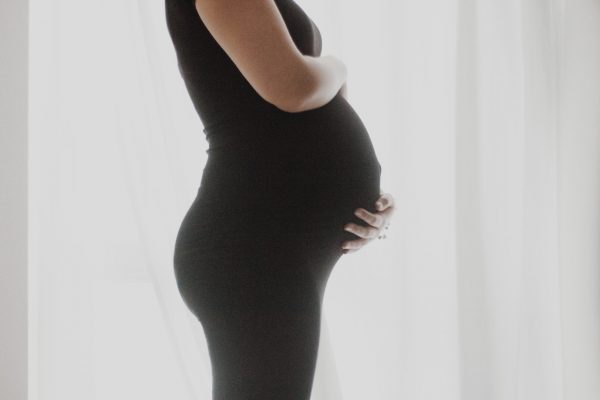
Our “Your Stories” series are submissions shared with us via email or in one-on-one interviews, for the purposes of our research and campaigns. All names have been changed (unless the use of real names was explicitly permitted by the author), and we have sought permission to publish from the authors/interviewees themselves. The opinions expressed in these posts do not represent those of AWARE.
Y.H.: In June 2018, I presented a doctor’s note stating that I was pregnant to my direct manager. Two days later, my general manager texted me that she needed to see me once I reached work.
When I went to see her, she brought me into the HR room to see the assistant HR manager. Both of them sat me down. There was a doctor’s note in my general manager’s hands, which stated that, as a precaution, it was not advisable for a pregnant woman to stand for extreme long hours or carry heavy items.
My general manager told me that she couldn’t have a visual merchandiser who was not in an ideal physical condition. They presented me a contract to change my position to “admin assistant”, with a more than 35% pay cut, to $2,000/month. This contract would be effective the following Monday. They said this was to cater to my physical condition, and that they would review if I were able to go back to my original post after I delivered.
I had joined this company in 2016 and found out about my first pregnancy in early 2017. During that time, this general manager had not yet joined this company, and I was able to keep my position with the same salary. The nature of my job was not just carrying heavy cartons and climbing ladders, etc. Our day-to-day work involved planning for road shows, carrying out campaigns and liaising with vendors and shop staff. As there was a team of visual merchandisers handling different brands, my reporting manager adjusted my workload during my first pregnancy by getting my colleagues to carry out the heavy-duty work, like carrying heavy cartons and carrying heavy props. I did more paperwork and planning. I still went out to store visits with a big tummy and set up for road shows. I did not receive any extra privileges, except for being exempt from carrying very heavy cartons in the warehouse.
The day I spoke to my managers, I checked with a Ministry of Manpower officer to get advice on what the company was doing to me. She mentioned that they could not force me to sign that contract to change my work designation with the pay cut.
However, when I went back to reject the contract, HR said that, regardless, the company could carry out the contract and adjust my position and pay the following Monday.
I felt that if I continued to stay, it would be such a blow to my integrity. I would not be able to handle being there, mentally and emotionally. I decided to quit on that day itself and I wanted a waiver on my notice. This was quickly agreed upon by the CEO when the HR brought this up to him. I left the company that day.
I asked HR for some form of compensation, as it was very obvious that the manager and company had been looking for a way to get rid of me, as they knew they couldn’t fire a pregnant woman. HR’s response was that the company would not give me any compensation, as they were not forcing me to leave, but rather changing my designation to cater to my physical condition.
I wasn’t pushed over the edge by this one incident. Years of discrimination had built up to that one moment. In fact, it was not the first time that the company had tried to make me leave. During my first pregnancy, I did not get much help and support, and was ask to take two months unpaid leave. On my first day back from maternity leave, I was asked to leave because I wasn’t suitable to carry out my job anymore as a mother. I told my immediate boss that, regardless of my new responsibility, I still loved the work I was doing and would continue doing it even if it was not for this company. As they were short of manpower, they decided not to let me go, but to put me on another three months of probation. I had still not been “confirmed” by June, when I left.
I know in my heart that I did my job the best I could. I was even given a promotion in May 2018. Yet when they found out I was pregnant in June, they started in with all these excuses about my bad performance and how I couldn’t cope with the physical work. I couldn’t tolerate this unfairness. I have submitted an appeal with MOM and am waiting for an investigation.
I’m sharing this story because I feel that people out there need to know that unfair treatment and prejudice happens to pregnant women and mothers in Singapore. Just because we need to take leave for medical care, maternity leave or leave for our children does not mean we are unable to do our work responsibly. I hope that after my story, other mothers and mothers-to-be know that they are not alone.
If you are facing discrimination at your workplace, you can call AWARE’s Workplace Harassment and Discrimination Advisory (6777 0318, Mon-Fri, 10am – 6pm). An advisor will listen to your experience and suggest some options based on your situation.

How do you talk to your children about sex?
It’s a topic that many parents are happy to put off discussing for as long as possible. But what are the consequences of making home an environment where talks about physical intimacy are off-limits?
Birds & Bees is an experiential workshop for parents, run by parents, to help you start and sustain the important conversation about sex – in a non-judgmental way. No matter where you are in your parenting journey, this workshop will allow you to:
Through case studies, role-play and facilitated discussions, the workshop will give you a chance to think more deeply about your values and sexual health knowledge, and improve communication with your children.
Birds & Bees is a programme for all parents, though the workshop covers issues most relevant to parents of teenage children (12- to 18-year-olds).
Date: 16 March 2019 (Saturday)
Time: 10am – 1pm (3 hours)
Venue: AWARE Centre (5 Dover Crescent #01-22)
Workshop Fee: $25
Survey: After you sign up, you will be asked to complete a short pre-workshop survey about the age(s) and number of your children. We will try to group participants with children of similar ages together during the workshop.
Refunds and cancellations: Unfortunately we will not be offering refunds. However, with minimum two days notice, you may switch to a future workshop date. If you need to do so, or if you have any other questions, please email Joo Hymn at publiceducation@aware.org.sg.
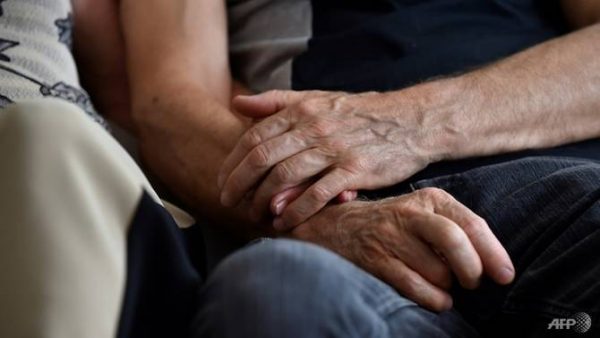
This post was originally published on Channel NewsAsia on 24 February 2019.
by Shailey Hingorani, AWARE’s Head of Research & Advocacy
Consider how financial payments for family care can address the economic consequences of family caregiving, and how their impact can be maximised by providing linkages to other policy domains such as employment and formal care, says AWARE’s Shailey Hingorani.
SINGAPORE: During his budget speech, Finance Minister Heng Swee Keat acknowledged the economic impact of caregiving on women when he announced that the 300,000 Singaporeans, aged 50 to 64 in 2019, to benefit from the CPF top-up of up to S$1,000 will mostly be women.
Many, he said, “left the workforce early, and took up important roles as mothers, caregivers or housewives.”
In a similar vein, last week the Government announced a monthly Home Caregiving Grant (HCG) of S$200 to replace the monthly Foreign Domestic Work Grant of S$120. This would allow care recipients to choose their preferred care options.
One of these options is paying their family caregivers, who more often than not are their female spouses or unmarried daughters. HCG and other similar measures, like more respite care options and increased budget for Flexible Work Arrangements, are part of the government’s new initiative to beef up support for family caregivers.
A SUBTLE SHIFT THAT MISSES THE MARK
The CPF top-up and HCG are significant because they are indicative of a subtle shift in policy thinking.
They recognise the financial cost of family caregiving by providing a CPF top-up for low-income individuals who have less than S$60,000 in their retirement savings, and for the first time, a financial payment to family caregivers of seniors to defray costs associated with long-term care.
But a one-off S$1,000 top-up and a grant of S$200 aren’t enough to compensate caregivers for foregone earnings. Nor do they cover out-of-pocket care-related expenses, such as salary payments to foreign domestic workers (FDW).
AWARE has advocated for CPF top-ups and a caregivers’ allowance through its annual Budget submissions, not only as a measure to acknowledge the economic burden of caregiving – which is substantial – but also to offer societal recognition of the valuable work done by family caregivers.
CPF top-ups and HCG are crucial first steps. Yet countries that offer caregiver payments, allowances and supplements show Singapore how far we have to go.
These countries, such as Australia and Ireland, comprehensively recognise that payment for family care must take a serious view of the economic consequences of family caregiving, and provide easy linkages to formal care services so that caregiving responsibilities can be shared between home and community.
ECONOMIC CONSEQUENCES OF FAMILY CAREGIVING
1. Decreased labour force participation. Unlike the emotional and physical burdens of family caregiving, which are relatively well documented, caregiving’s economic consequences have not received as much attention from policy makers.
These consequences include loss of income and retirement savings (because of reduced, delayed or interrupted labour force participation); out-of-pocket expenditure of co-payments for formal services to complement family care; and additional expenses incurred in the consumption of care-related goods and services.
These are significant costs for all family caregivers regardless of income, but more so for the low- to middle-income persons that the CPF top-up is targeted at.
An analysis of the Labour Force Survey from 2016 to 2018 shows a marked increase – from 39,300 to 75,800 – in the number of women who cited caregiving for relatives and older persons (and not children) as their main reason for being out of the labour force.
We see a similar increase in the numbers of men citing caregiving for relatives and older persons over the same time period – from 8,200 in 2016 to 13,000 in 2018.
2. Cost of hiring help at home. According to MOM, there are 250,000 FDWs in Singapore today. Although there is no publicly available data on how many of these care for older persons, the last national survey on informal caregivers conducted in 2011 pointed out that Singaporean families care for their old members with a heavy reliance on FDWs.
Given shrinking family sizes, the reliance on FDWs is only set to increase, as are the associated expenses for paying them.
A forthcoming study from AWARE that interviewed 23 family caregivers (between the ages of 45 and 65) of seniors shows that salary payments to FDWs are the single largest recurring out-of-pocket expense for families, even after subsidies.
On average, caregivers spent S$655 per month per FDW. The HCG payout, which is S$80 more than the FDW Grant, would bring this cost down but not substantially.
FINANCIAL PAYMENTS FOR CAREGIVERS – TWO APPROACHES
Many experts acknowledge that financial payments for caregivers cannot fully compensate for foregone earnings, for the full value of the care work performed costed to the level of payment for full-time salaried care workers, or even for the largest out-of-pocket expenses.
But policies can be designed to be effective even while offering low sums.
They can provide automatic access to formal care services so that caregivers do not have to incur the time cost of applying for these services separately, and provide insurance cover for temporary periods of unemployment, to ensure that family care does not completely impoverish caregivers.
Financial compensation policies can be targeted at either care recipients to allow them greater flexibility in choosing their preferred care options, including payment to a family caregiver – although this might impose an administrative burden on care recipients who require care support precisely because they are unable to perform Activities of Daily Living by themselves. Or they can be targeted at caregivers.
Both approaches have implications for how we conceptualise the relationship between care recipients and caregivers, the transaction costs involved in accessing financial payments, and what impact, if any, providing cash for care has on the caregivers’ ability to participate in the labour force.
FINANCIAL PAYMENTS TO CARE RECIPIENTS
Countries such as Austria, France and Germany have adopted this approach to offer financial payment to care recipients without any formal requirements for how it should be used. Singapore too has firmly gone in the direction of this approach.
However, Singapore’s approach departs from Germany’s policy design by being government sponsored, and by keeping financial payments transferable to caregivers separate from their eligibility to access community- and home-based care.
Germany’s approach – insurance-based integrated financial payment and access to services – automatically activates when care recipients who are able exercise the choice to transfer payments to caregivers.
Upon receiving payments, caregivers are entitled to four weeks of respite care and contributions to their pension and accident insurance.
The integrated approach seems more comprehensive because it provides care recipients greater flexibility in choosing their preferred care options through individual consultations with care advisors and minimises the transaction costs for caregivers to access home- and community-based services (because they are automatically enrolled).
The Government in Singapore has announced more respite care options, which will definitely help with the caregiving burden. However, from the details available in the public domain so far, it does not seem that the Government will adopt the mixed-model approach of Germany.
FINANCIAL PAYMENTS TO CAREGIVERS
Some consider the second approach, adopted by countries such as Australia, to be more radical because it recognises that caregivers have a right to a source of income independent of the rights, entitlements or wishes of care recipients.
This approach is arguably the more expensive option, but the Government could finance it by considering progressive taxation measures, like increasing personal income tax for the wealthy, or introducing a wealth tax (e.g. capital gains tax, inheritance tax).
This approach encompasses at least two different policy designs: Providing payment to low-income caregivers for providing full-time care, and providing employment insurance during temporary absences from employment because of caregiving responsibilities.
Australia costs these to provide substantial financial relief to caregivers.
Family care has been undervalued for far too long. HCG and other measures to support caregivers are welcome, but Singapore can and must do more to recognise the unsung heroes of our time.
We must carefully consider how financial payments for family care can address the real economic consequences of family caregiving, and how we can maximise their impact by providing linkages to other policy domains such as employment and formal care. Our caregivers deserve to be cared for too.
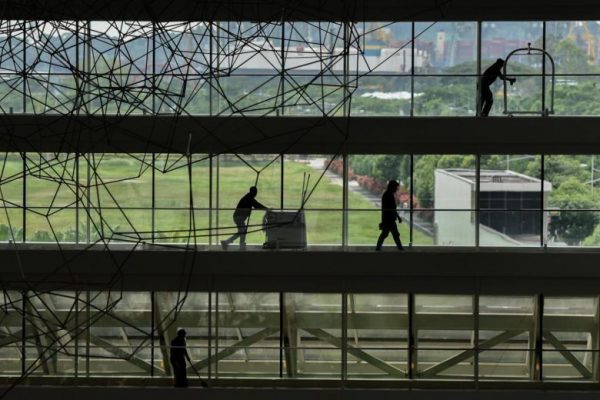
This letter was first published by The Straits Times on 22 February 2019.
We refer to the report (NTUC urges higher wage payouts for younger low-income workers, Feb 13).
The Association of Women for Action and Research (Aware) agrees with NTUC’s point that, if the Workfare Income Supplement (WIS) is intended to be an income supplement to reduce income inequality, then it should be pegged only to income, and not age and income as it currently is.
NTUC proposes that all workers regardless of age receive the same quantum payout. We want to push the envelope on this recommendation and urge the Government to consider lowering the current age eligibility criteria of 35 for lower-income families.
Our experience showed that many of the lower-income workers were second-generation poor who were forced to prematurely stop their education at the N or O levels to supplement their household incomes.
Although they averaged 36-40 years in age, they were still working in the same type of jobs in F&B and retail, and earning more or less the same income, as when they first started work at 16 years old.
To break the cycle of poverty, we should supplement the income of these second-generation poor workers at the time they start having children.
Thus, WIS eligibility for low-wage workers with children should be pegged at 30, the median age of the mother at first birth, or at the time the lower-income worker has his or her first child.
The earlier intervention will go some way to prevent a further cycle of poverty.
NTUC also points out the disparity in the needs of lower-income employees – who require cash for daily expenses – and the payout structure of WIS, which favours CPF to cash payouts in a ratio of 60:40.
This disparity is even starker for the lower-income self-employed, with Medisave to cash payouts at a 90:10 ratio.
We too urge the Government to review this so that it does not deplete the cash that low-income employees and the self-employed have available for immediate needs.
Finally, we must make a concerted effort to reach out to the large numbers of working poor who are not in formal employment.
These workers tend to be in ad-hoc jobs. They are technically covered by WIS under the self-employed category but many of them, are not aware of this.
We urge the Manpower Ministry to help this group access WIS benefits.
Shailey Hingorani (Ms)
Head of Advocacy & Research
AWARE